| Musical innovation The last of the four general areas of modal activity within the motet is specifically musical. In addition to the manipulation of borrowed teχt (in the refrain) and music (both in the refrain and tenor),the composer contributes new musical material to the motet. モテット内の様式活動の4つの一般的領域の最後は、特に、音楽の関してのことである。借用されたテキスト(refrain内で)と音楽(refrainとテノール内で)の操作に加えて、作曲者は、モテットに対する新しい音楽素材を提供した。 When the composer turns his hand to fusing borrowed tenor and perhaps a borrowed refrain, he does so by the addition of music. Consistent melodic patterning, characterised by repetitions of phrases, is something of a rarity in the parts of motets that are newly composed. Many phrases begin the same way but invariably change course after the first few pitches. We need to be able to quantify how this particular melodic style behaves. 作曲者が、借用されたテノールとおそらくは借用されたrefrainを接合しようとした時、彼は、音楽の付加もまた行っている。繰り返しのフレーズによる一貫した旋律パターンは、新たに作られたモテット部分においてはいくぶん珍しい。多くのフレーズは同じように始まるが、最初の数ピッチではほとんど変化はない。我々は、いかにこの特殊な旋律スタイルが振舞うかを考えることができる。 In the motetus of (83) L'autrier mesbatoie ―(84) De!menant grant joie - Manere (M5), there are two pairs of identical phrases, starting at (a) perfections 75 and 81, and (b) perfections 13 and 25. So many of the other phrases seem to begin in a consistent way, and then diverge. Example 8.5 graphs the melodic structure of the motetus in a manner familiar from the analysis of the motets entes from fran^ais 845 1n Chapter 4. (83) L'autrier mesbatoie ―(84) Demenant grant joie - Manere (M5)のmotetusにおいては、同一のフレーズの2つのペアがある。 (a) perfections 75~ and 81~, そして (b) perfections 13 and 25である。他のフレーズの多くは、一貫したやり方で始まり、そして拡大しているように見える。Example 8.5 は、第4章で示したfran^ais 845中のmotets entesの分析から明らかになったやり方で、motetusのメロディ構造をグラフ化したものである。 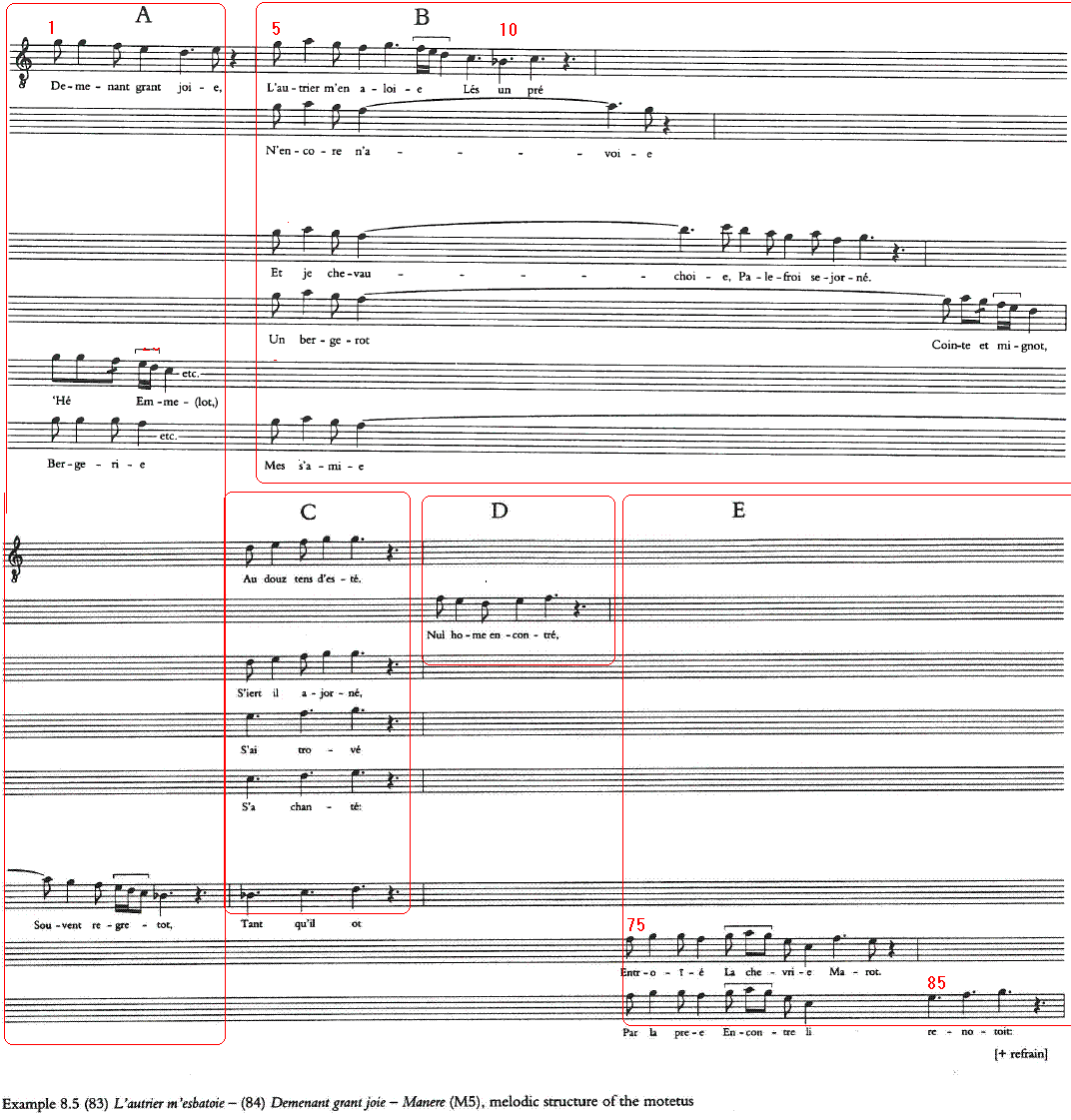 The analysis shows how far removed is the melodic construction of this voicepart from that of the motets in fran^ais 845. Only two of the paradigms describe simple melodic repetition: C and E. Even paradigm E needs qualification. The graph shows the ways in which the paradigms break down. このアナリーゼは、この声部のメロディ構造がどのようにfran^ais 845中のmotetus中のそれから切り離されたか、を示している。パラダイムのわずか2つが単純なメロディの繰り返しを記している(CとE)。パラダイムEでさえ、説明を要する。グラフはパラダイムが分解するやり方を示している。 In paradigm B, for example, five phrases begin with the same four pitches and then change. There is a clear difference between the multiple evolution of phrases in paradigm B and the single repeated phrase in paradigm C. Exactly how the last two members of paradigm A function is open to question. The inclusion of the third, and especially the fourth, member of paradigm C is similarly dubious. パラダイムBにおいてはたとえば、5つのフレーズが同じ4つのピッチと共に始まり、そして変化する。パラダイムBにおけるフレーズの多数の開発とパラダイムCにおける単純な繰り返しフレーズの間には、明確な違いがある。正確には、最後の2つのパラダイムAのメンバーがどのくらいであるかについては、疑問がある。3番目、4番目を含めると、パラダイムCのメンバーもまた同様に疑わしくなる。 The third member is found also in the triplum which is not graphed here. The triplum behaves in a broadly similar way, although its paradigms are different. From an analytical perspective, the shared material between the voice-parts, and the exactly repeating elements in paradigms C and E in the motetus, emerge as the modal dominants that characterise this particular motet. 3番目のメンバーは、ここではグラフ化されていないriplumにも含まれている。triplumは同様に広く振舞う。そのパラダイムは異なっているが。アナリーゼ的観点から言えば、共有された声部素材や、motetus内のパラダイムCやEの正確な繰り返し要素は、特殊なモテットを性格付ける様式支配として出現する。 To the ear, however, the phrases under paradigm B that use the same opening formula and then diverge are the most striking. They too have a claim as modal dominants. Although this tension is an interesting characteristic of the motet, the point to be stressed is that the dominant mode is one that is associated with newly composed music, not, for example, refrain or poetic mode. 耳においてはしかしながら、同じオープニングフォーミュラを使うパラダイムB下のフレーズと多様性は、もっとも注目すべきことである。それらもまた様式支配としての主張をしている。このtensionはモテットの性格としては興味深いが、強調された点は、様式支配は新しく作られた音楽と関連するものであり、たとえば、refrainや詩の様式とは異なる。 Some melodic practices are tied to melodic patterning in the refrain. In the discussion of (9) Amoureusement me tient― (10) He, Amours ― Omnes (Ml) in Chapter 6,we saw how two refrains were each used twice, once in each voice-part. Their music was presumably borrowed. Between them, they occupied a large proportion of the melodic superstructure of the motet. いくつかのメロディの実践は、refrainのメロディーパターンと結びついている。第6章において論ぜられた(9) Amoureusement me tient― (10) He, Amours ― Omnes (Ml) において、我々は、2つのrefrainが、それぞれどのように2回使われるのか、それぞれの声部では1回使われるかを見た(http://machikun.la.coocan.jp/frenchmotet11.htm)。そうした音楽はおそらくは借用されたものであった。それらのあいだで、refrainはモテットのメロディの上部構造の大部分を占めていた。 A further example of melody as one of the dominant modes of a motet is (290) Emi, emi Mawtele ― (291) Emi, emi Marotele一Portare (M22). Extracts from the work (perfections l-4, 13-16 and 45―8) are given as Example 8.6. The refrain consists of the pair of lines: ‘Emi, emi Marotele/Voz traires I'ame de mi'. These occur in other sources, but are here divided into two, and placed at the beginning and end of the motetus. The text alone of the refrain is duplicated in the triplum, both at the beginning and the end.24 The music is different. We may be certain that the melody of the original refrain occurs in the motetus because it is also preserved in other sources of the refrain. 24 This has already been seen in L'autrer m'esbatoie(see above PP. 158--60). モテットの支配的モードの一つとしてのメロディのさらなる例は、(290) Emi, emi Mawtele ― (291) Emi, emi Marotele一Portare (M22)である。Example 8.6にここからの一部 (perfections l-4, 13-16 and 45―8)が示されている。refrainは行のペア ‘Emi, emi Marotele/Voz traires I'ame de mi'. として存在している。これらは他の資料にも見られるが、2つに分けられ、motetusの最初と最後に置かれている。refrainの歌詞のみは、triplumにおいて倍増され、両者ともに、最初と最後にある。音楽は異なっている。オリジナルのrefrainのメロディはmotetusに出現する。なぜなら、それはまた、他の資料にも残っているからである。  The concept of free melodic repetition is however new. Counterpoints are composed to accompany an imported melody, and come to be repeated with the imported melody, and hence to influence the structure of the motet. The contrapuntal line in the triplum that accompanies the second line of the refrain (i.e. the last line of the motetus) is repeated in the middle of the triplum. As may be seen in Example 8.6, perfections 13-16 and 45―8 are musically identical. These repetitions are independent of the refrain. Although the triplum music of the last four perfections of the piece draws analytical attention to the passage in perfections 13-16, the text of the triplum draws attention to the beginning and end of the motetus. 自由なメロディの繰り返しの概念はしかしながら、新しい。対位法は重要なメロディに伴って作られ、重要なメロディとともに繰り返される。refrainの第2行(すなわちmotetusの最後の行)に伴うtriplumにおける対位法的的流れは、triplumの中心で繰り返される。Example 8.6に示されるように、 perfections 13-16 と45―8 は、音楽的には同一である。これらの繰り返しは、refrainとは独立である。作品最後の4perfectionのtirplumの音楽は、perfections 13-16において、アナリーゼ的注目を浴びるが、triplumの歌詞はmotetusの最初と最後で注目を浴びる。 Sequence and canon are two compositional resources used to great effect in the organa of Perotinus. (459) Names sui au cuer ― (460) Navres sui pres du cuer一Veritatem (M37) is a motet in which melodic repetitions are found. A motetus phrase near the beginning of the piece is repeated towards the centre and clearly straddles the end of the first and the beginning of the second tenor cursus. This is a response to the organisation of the tenor. The repetitions in (661) Quant define la verdour(662) Quant repaire la dolcor Flos filius eius (016) are slightly different. Example 8.7 gives an excerpt。 連続性 と模倣(カノン)は、ペロタンのオルガヌムにおいて、大きな効果があった2つの作曲上のリソースである。(459) Names sui au cuer ― (460) Navres sui pres du cuer一Veritatem (M37)は、メロディの繰り返しが見られるモテットである。作品の最初あたりのmotetusのフレーズは、中心に向かって繰り返しをし、はっきりと、第1cursusの終わりと第2cursusの最初の間を跨いでいる。これはテノールの組織化への応答である。 (661) Quant define la verdour(662) Quant repaire la dolcor Flos filius eius (016) 中の繰り返しは若干異なる。Example 8.7 はその抜粋である。 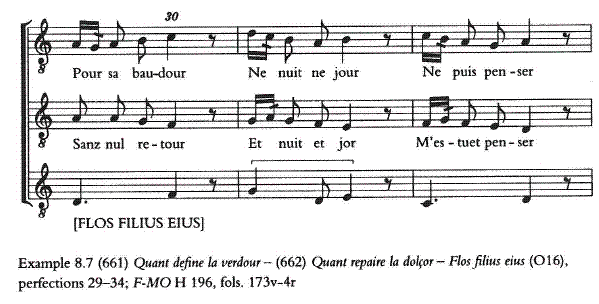 The repetitions in the motetus are clearly sequential. The participation of the triplum and tenor in the sequence is slight. The triplum follows the pattern only for the last two of the three limbs of the sequence. The last note of each of the three tenor phrases doubles the cadence note of the motetus. motetusにおける繰り返しは、はっきりと連続している。triplumとテノールのこの連続への参加は若干である。triplumは、sequenceの3つのlimbsのうちの最後の2つに対してのみ、パターンをフォローする。3つのテノールのフレーズのそれぞれのうちの最後の音符は、motetusのカデンツの音符と同じ音になっている。 In (561) Rims nt!puet ma grant folie - (560) Riens ne puet plus doumagier一Aperis (M69), three passages in canon are found. In the first, the second phrase begins only in the last couple of perfections of the first. But in the other two passages, the comes follows the dux at a distance of only one perfection. Particularly striking, however, are the verbal correspondences between the texts of triplum and motetus. The text in both dux and comes is the same. Textual processes in this motet lead musical ones。 (561) Rims nt!puet ma grant folie - (560) Riens ne puet plus doumagier一Aperis (M69)においては、3つのカノンのパッセージが見られる。最初は、第2フレーズは最初のひと組のperfectionにのみ始まる。しかし、他の2つのパッセージにおいては、comesは1perfectionの差でduxに従う。特に注意すべきことは、triplumとmotetusの間の言葉の対応である。dux とcomesの歌詞は同じである。モテットにおける歌詞化の過程は音楽化のそれを導いたのである。 There is a similar pattern in (124) Vilene gent ― (125) Honte dolor一Hec dies (M13), an edition of which is given as Example 8.8. Two phrases marked with brackets crossed once (motetus, perfections 17-20 and triplum, 21―4) behave similarly to those in Rien ne puet ma grant folie. The phrases share the same text and music. As the teχts diverge, so do the musical phrases. These two phrases begin very similarly to the opening of the motetus voice. The other two phrases (motetus, perfections 9-16 and 25―32) are musically identical, but apart from rhyme, they share no poetic content. モテット(124) Vilene gent ― (125) Honte dolor一Hec dies (M13)においても、Rien ne puet ma grant folie.同様のカノンパターンが見られる( Example 8.8)。このフレーズは音楽と歌詞と両方を共有する。歌詞が多様性があるように、音楽もまたそうなっている。これらのふたつのフレーズは、motetus声部の最初で非常に似通って始まる。他のフレーズ(motetus, perfections 9-16 and 25―32)は、音楽的には同一であるが、韻はなく、詩の内容は共有していない。 The first element ends with the words ‘Vileine gent' that are found at the beginning of the triplum. The words are derived in turn from the first words of the refrain in the motetus, and prompt the refrain in the triplum. This is paralleled by the musical prompting of the refrain in perfections 43-5 of the triplum. The descending fifth g to c that prompts the refrain in the triplum and begins it in the motetus, is also present in perfections 15-16. Here, it seems to highlight the end of the first phrase of melodic significance in the motetus, and the beginning of the simple canon that occupies perfecctions 17-24. It is also found in perfection 31、 exactly at the end of the second statement of the second repeating phrase。 第1要素はtriplumの最初に見られる‘Vileine gent' という言葉で終わる。この言葉はmotetusのrefrainの最初の言葉に由来し、triplumにおいてrefrainを強調する。これは、triplumのperfections 43-5のrefrainの音楽的強調と並行している。ソ音からハ音への下降5度は、triplumにおけるrefrainの強調し、そこからmotetusにおいてrefrainが始まるが、それはまた、perfections 15-16においても認められる。ここでは、motetusにおけるメロディの重要性の最初の局面の最後を飾ることになり、perfecctions 17-24の単純なカノンの始まりともなる。perfection 31においてはまた、第2の繰り返しフレーズの第2局面の正確な終わりとなっている。  The use of a melodic repetition that is unrelated to textual duplication is one of several modes in this motet. We may add it to repetitions that include textual repeats, and the use of a terminal refrain in the motetus, as modal elements characterise the generic status of this work. There is, however, a structural importance to these apparently competing modalities. They are deployed in a linear and complementary fashion. There are very few points in the piece where one or other of these elements is not at work. 歌詞には無関係なメロディの繰り返しの使用は、このモテットのいくつかの様式のうちの一つである。我々は、そこに、歌詞の繰り返しを含む繰り返しを付け加えたい。さらにはこの作品の一般的状態を表す様式要素として、motetusにおける最後のrefrainの使用についても。しかしながら、そこには明らかに様式と競合するような構造的重要性がある。それらは直線的かつ補正的流れで発展させられる。こうした要素が働かない作品には、こうした点がほとんどない。 Musical repetition may occur in two voices simultaneously. Example 8.9 is an extract from (678) Bele Aelis qar matin ― (679) Haro, haro!一flos filius eius (016) where there is a melodic repetition of a piece of two-part counterpoint. The repeating triplum phrase cadences at the same time as the repeating motetus phrase begins. The passages are boxed in the example. Although the contrapuntal pairing of the first of the two phrases might be the result of the presence of the word ‘deport' in both triplum and motetus texts, this is not the case with the second of the two phrases. A strictly musical impulse generated this patterning。 音楽的な繰り返しは、2声で同時に起こることもある。Example 8.9は、モテット (678) Bele Aelis qar matin ― (679) Haro, haro!一flos filius eius (016)の例である。そこでは、2声の対位法の作品のメロディの繰り返しがある。繰り返しをするtriplumのフレーズは、繰り返しをするmotetusのフレーズが始まるのと同時に終止する。該当するパッセージは、この例では、ボックスで示されている。ふたつのフレーズの最初のペアはtriplum,motetus双方の歌詞では‘deport'という言葉が存在しているが、これは、2つのフレーズの第2のケースではこうなってはいない。厳密には、音楽的衝動がこのパターンを作り出した。 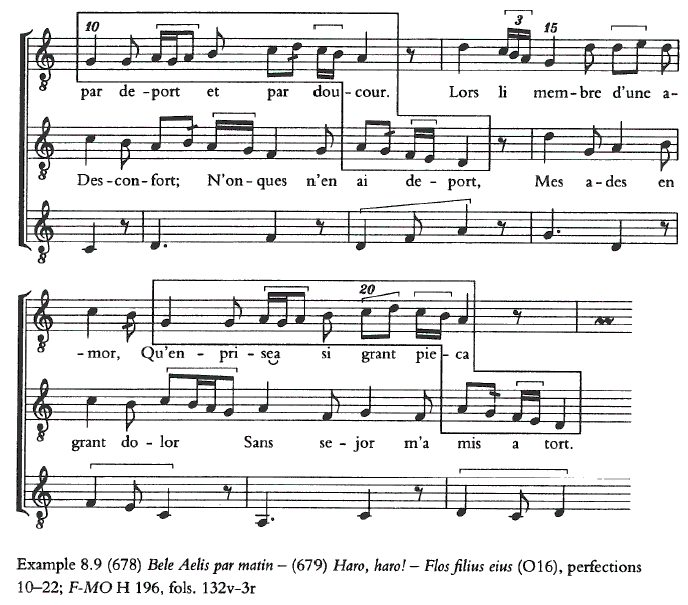 Much melodic repetition in the upper voices of motets is tied to the structure of the tenor. Such a procedure has the effect of enhancing the structural force of a multiple tenor cursus. In such cases a generic mode associated with melody creates a motet with a strong structural profile. The music in previous examples concentrated on outlining cross-references between portions of the melodic line or between two voice-parts. Two cases where the tenor is also included may serve as examples. The tenor of (13) Qui bien aime,il ne doit mie― (14) Cuer qui dort Omne(M1) consiss of two cursus of sixteen perfections each. For the first five perfections of each cursus, the triplum is almost exatly the same. Similarly・(21) II n 'a en toi - (22) Robin,li mauves ovrier - Omrtes (Ml) also has a tenor consisting of two cursus of sixteen perfections each (the pattern is different to the previous piece however). The motetus phrases in the second half of each curus are, apart from fractional changes to the end of the second one, identical to their counterparts in the first cursus. The positioning of the repetitious par‘t of the motetus is a precursor of the interaction of upper voices and tenor in the fourteenth-century isorhythmic motet.25 モテットの上声部の多くのメロディの繰り返しは、テノールの構造と結びついている。こうした過程は、多くのテノールのcursusの構造力を高める効果を持っている。こうしたケースでは、メロディと関連した一般的な様式は、強い構造的profileとともにモテットを創造する。以前の例の音楽は、メロディー間の、あるいは2声部の間のoutlining crossに集中していた。テノールもまた含まれる2つのケースがその例となる。 When principles of melodic repetition take over the functioning of all three voice-parts, the relationship between texture and structure that is one of the consistent characteristics of the thirteenth-century motet is under severe threat. This principle, carried to its logical conclusion, produces motets later in the century, the structure of whose French-song tenors is reflected exactly in both upper parts. These are critical to the evolution of polyphonic song c. 1300. メロディの繰り返しの原理がすべての3声部の機能を引き継いだ場合、、13世紀のモテットの一貫した特徴のひとつである肌理と構造の関係は、深刻な脅威に晒される。この原理は、その論理的必然として、フランスの歌のテノールが上声部に正確に反映されている構造のモテットを13世紀後半に生み出す。これらは、およそ1300年頃の多声歌の進化にとって重要である。 We can see this principle in embryo in (716) He, Marotele ― (717) En la praerie-Aptatur (045). There are three identical statements of the tenor; each is of thirty-two perfections duration. In perfections 17-23 of each cursus, not only does the motetus present exactly the same melodic profile in each case, but the triplum also participates in the process. Examples 8.10.1-3 show the three corresponding passages one above another. The three motetus phrases are exactly the same with the exception of the last two notes in the third statement. The role played by the triplum is rather more subtle. It balances all three phrases. The first two phrases, (1) and (2), leave a perfection's rest above the beginning of the motetus phrase. The triplum starts at the beginning of the next perfection. In the third phrase, (3),this space is filled. However, the contrapuntal line in the triplum in perfections 3-4 0f each phrase is identical in phrases (1) and (3) and differs from phrase (2)。 我々はモテット(716)He、Marotele - (717)En la praerie-Aptatur(045)において、この原則の萌芽を見ることができる。そこにはテノールの3つの同一の音型がある。それぞれは32perectionの長さから成っている。それぞれのcursusのperfections 17-23において、motetusはそれぞれのケースに同じメロディのプロフィールを提示するだけでなく、triplumもこの過程に参加している。Examples 8.10の1-3は、互いの相当するパッセージを示す。3つのmotetusのフレーズは、3番目の音型の最後の2つの音符を除いて全く同じである。triplumの役割はかなり微妙である。 3つのフレーズはすべてバランスを取っている。最初の2つのフレーズ(1)と(2)では、冒頭motetusフレーズの上にperfectionの休符がある。triplumは、次のperfectionの始まりから開始となる。第3フレーズ(3)では、このスペース((1)と(2)では休符だった部分)が埋まっている。しかし、perfections 3-4のtriplumにおける流れは、フレーズ(1)およびフレーズ(3)において同一であり、フレーズ2)とは異なる。   モテット(716)He、Marotele - (717)En la praerie-Aptatur(045)のテノール旋律。これが3回繰り返される The recurrence of motetus phrases in a double cursus tenor permeates the entire substance of (781) Encontre le mois d'Avril - (782) Amours, tant voz ai servi - Neuma(Neuma ⅠToni. Mo189v-191 ). In this three-part motet, two identical tenor cursus divide the piece into equal halves. An edition is given as Example 8.11. The motetus consists of ten phrases of four perfections each: five in the first half of the piece, five in the second. The beginnings of both first phrases, both second phrases and so on are identical in four out of the five instances. The pairs are marked A-D. The two A phrases begin in the same way, as do the two B phrases. Phrases C and D behave similarly. No matter how far each phrase subsequently deviates, the next phrase always begins again in exactly the same way in each half of the piece. The final phrase is different. and imparts a degree of cadential function to a composition whose structure was likely to be problematic with regard to closure. The triplum behaves in a rather similar fashion, although the parallelisms are rather looser. Structural pitches and contours remain the same, but ornamental figurations change。 double cursusのテノールのmotetusの再出現は、モテット (781) Encontre le mois d'Avril - (782) Amours, tant voz ai servi - Neuma(Neuma ⅠToni. Mo189v-191 )の全体を貫く。。この3声モテットでは、2つの同一のテノールcursusが作品を2等分している(Example 8.11)。motetusは、それぞれ4perfectionの10フレーズからなっている。5つづつ前半と後半で。第1フレーズ、第2フレーズ、およびそれ以降、両方の開始点は、5つの各のうち4つで同一である。それぞれのペアはA-Dとマークされている。 2つのAフレーズは、2つのBフレーズと同じように始まり、フレーズCとDも同様に動作する。各フレーズがその後どのように逸脱しても、次のフレーズは常に作品のそれぞれの前半、後半で全く同じ方法で再び始まる。最後のフレーズは異なっており、その構造が終止に関して問題となる可能性が高い作品に、ある程度のcadential機能を付与する。 triplumは類似した振る舞いをするが、並列性はかなり緩やかである。構造的なピッチと輪郭は同じままであるが、装飾的な形状が変わる。 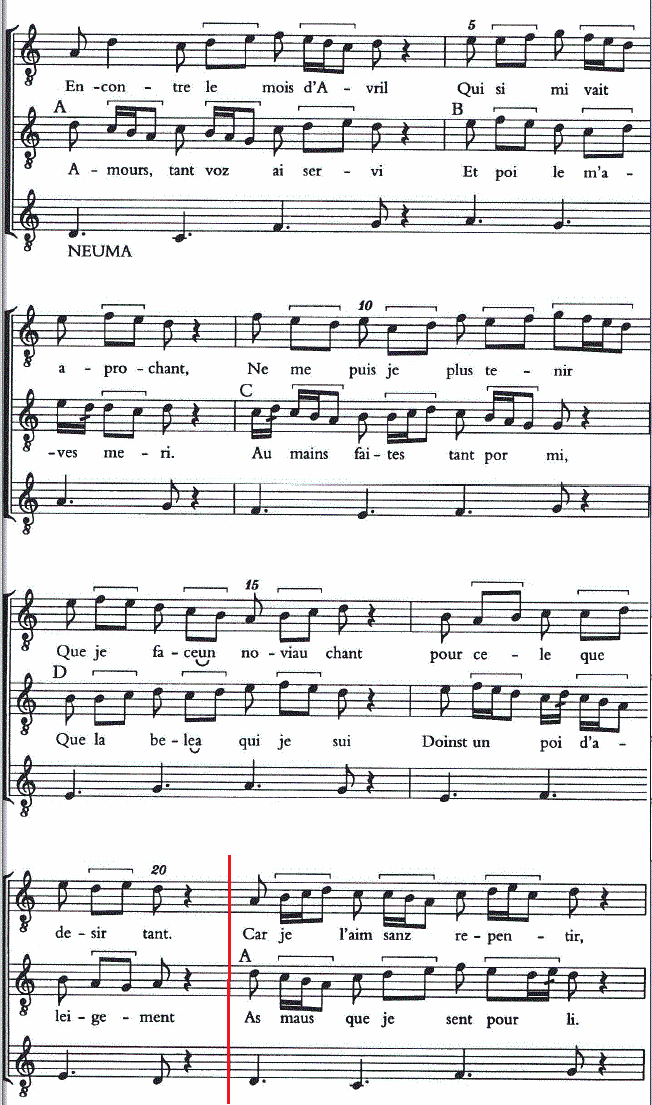 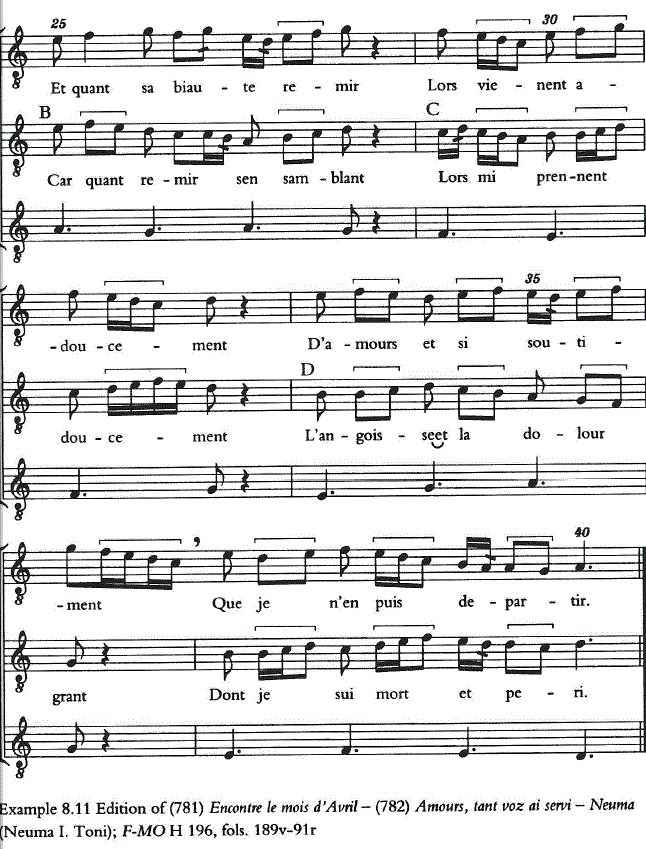 A fundamental characteristic of the style of the mid-century motet is the disparity between the poetic line-lengths and musical phrase-lengths of the two upper parts. We have already seen one example, however, where the upper voices behaved homorhythmically and were interrupted by a borrowed refrain. There is quite clearly important generic mode to be uncovered here in which poetic line length, musical phrase-length and rhyme play a role in the combination of the upper voices themselves and that of the upper voices with the tenor. 13世紀半ばのモテットのスタイルの基本的な特徴は、詩行の長さと2つの上声部の音楽フレーズの長さとの間の差異である。しかし我々は、上声部が同一リズム的に振る舞い、そしてそれが借用されたrefrainによって中断された例をすでに見てきた。ここでは、詩の長さ、音楽フレーズの長さ、韻が上声部同士の組み合わせと、テノールと上声部の組み合わせの役割を果たしていることを明確に示す重要な一般的様式がある。 (326) De jolif cuer ―(327) Je me quidai ― Et gaudebit (M24) is an excellent example of the ways in which these elements can interact. Both upper voices move systematically in phrases of exactly the same length throughout the piece because the poems share an identical structure. The end-rhymes are identical. The tenor consists of two complete cursus and one incomplete one. The first is constructed so that rests consistently coincide with the upper voices; the resulting texture is rather like that of the conductus. In the second and partial third cursus of the piece, the upper voices still move in similar phrase-lengths but they are now out of step with the tenor. Such a diversity of compositional viewpoint is in itself a modal attribute of the genre. The ability to choose whether or not to match articulations of the tenor with those of the upper parts is important. Deciding to do both in the same motet points to the relationship between tenor and upper-voice phrase as one of the work's dominants. モテット(326) De jolif cuer ―(327) Je me quidai ― Et gaudebit (M24)は、これらの要素が相互作用するやり方を示すよい例である。両上声部は、詩が同じ構造を共有しているため、作品全体で正確に同じ長さのフレーズで体系的に移動する。終わりの韻は全く同じである。テノールは2つの完全なcursusと1つの不完全なcursusで構成されている。最初のものは、休符が一貫して上声部と一致するように構成されている。結果として得られる肌理は、むしろ、conductusのそれにかなり似ているようになる。第2と一部が第3のcursus部分では、上声部は同じようなフレーズ長で動くが、テノールとの歩調からは外れている。このような作曲上の観点からの多様性は、それ自体がジャンルの様式への帰属である。テノールのarticulationと上声部のそれを一致させるかどうかを選択する能力が重要である。同じモテットで両方を行うことを決定することは、作品の支配の1つとしてのテノールと上声部との間の関係を示す。 Conclusion This outline of the various modes at work in the French motet has been given the form of eχamples, grouped according to, on the one hand, literary and musical divisions, and on the other, divisions between borrowed material (matiere) and elements related to entencion or compositional purpose. Tynjanov's preference was for a structured inventory that laid out the modal possibilities of generic elements. An attempt at such a structured inventory follows. The divisions between music and text, matiere and newly composed material, that have been used to organise this chapter are retained. Positive statements in the inventory include the possibility of the negative; ‘refrain interrupts prevailing rhythmic mode' implies its opposite: ‘refrain shares prevailing rhythmic mode'. フランス語モテットでの様々な様式の概要は、一方では文学的および音楽的な区分に基づいて、他方では、借用されたマテリアル(matiere)と entencion あるいは作曲目的の間で分割されたことによってグループ分けされた例の形式が取られた。 Tynjanovの好みは、一般的な要素の様式的可能性を提示した構造化された目録に対するものであった。 このような構造化目録の試みは次のとおりである。 この章を編成するために使用された音楽と歌詞、matiere(素材)と新しく作曲された素材の間の分割は残されている。目録中の積極的なstatementは、消極的なstatementを含んでいる。「refrainがリズムモードの流行を妨げる」ことはその正反対、すなわち「refrainはリズムモードを共有する」ことを共有している。 MODE Music (matiere) Clausula model Unrhythmicised tenor model Rhythmicised tenor model Tenor controls repetition patterns of upper voice(s) Teχtual innovation Language of text (subgenre) Latin motet French motet Bilingual motet Registral modes Aristocratisant Popularisant Pastourelle Chanson-requette Devotional motet Texting of clausula reflects original structure Upper-voice allusion To tenor incipit To text of plainsong To elsewhere in liturgy Refrains (matiere) Presence (absence) of refrain Text and music of refrain Text only of refrain Refirain interrupts prevailing rhythmic mode Refrain interrupts poetic pattern Line-length Rhyme Position of refrain Initial Internal Terminal Divided Upper゛oice(s) constructed exclusively from refrains Refrains control overall structure of work Refrains control rhyme-scheme of poem Poetic integration ofre&lin Grammatically L42χically Choice of person Tense Mood Register Musical innovation Autonomous repetition of melodic patterns Sequence Canon Repetition of melodic patterns related to refrain Repetition related to patterning of tenor Melodic repetition governed by textual repetition independent of refrains Parallel construction of series of melodic phrases Melodic repetition of two-part counterpoint Melodic repetition of entire texture (constructional type) CONSTRUCTIONAL TYPE Rondeau-motet Cyclic structures A generic definition of the motet may be derived from the way in which modes combine. Tynjanov stressed that the abstraction of elements is only a working hypothesis, and the function of such elements is the way in which they interact one with another in a given work.26 This is the basis of Tynjanov's characterisation of a genre as a dynamic [musico-]literary system in which elements constantly interrelate by playing different roles. He draws a further distinction, that may be of value to our enquiry, between what he terms ‘syn-function' and ‘auto-function'. The syn-function of an element is the way in which it interacts with different elements in a single work. Most of the examples discussed in this chapter have stressed the ways in which competing modes interact. Auto-function is the effect of an element being ‘interrelated with similar elements in other works in other systems'.27 Tynjanov's example is the lexicon of a given work shared both with a literary and a linguistic vocabulary. There is no shortage of auto-functions in the modes that constitute the motet. We may identify plainsong tenors, for example, and point to their use in other works (other motets). Refrains are used not only in other works, but also in other systems (chansons and romances, for example). モテットの一般的な定義は、様式が組み合わされる方法から導出されてもよい。 Tynjanovは、要素の抽象化は実用的な仮説であり、そのような要素の機能は、与えられた作業において互いが相互作用する方法であると強調した26。彼は、「syn-function」と「auto-function」という用語の間に、私たちの研究にとって価値があるかもしれないさらなる区別を引き出している。要素のsyn-functionとは、1つの作業を異なった要素で相互作用するやり方である。この楽章中で論議された多くの例は、競合する様式が相互作用する方法を強調している。「auto-function」は、他のシステムで他の作業をする時に同じ様な要素で相互関係する効果を言う。Tynjanovの持ち出した例では、文学語彙と語学語彙の両方で共有されている作品の辞書である。モテットを構成する様式には、 auto-functionsの不足はない。たとえば、我々はプレインソングのテノールを特定し、他の作品(他のモテット)での使用を指摘するだろう。 Refrainsは、他の作品だけでなく、他のシステム(例えば、シャンソンやロマンス)でも使用される。 We already use Tynjanov's concept of dominants to define a genre. So did medieval theorists. They defined the motet as a work based on a plainsong with more than one text. We might add some observations on format and notation. But this serves to distinguish between, for example, motet, conductus and chanson, not between subgenres or different works. Dominants of a work define that work's unique quality. ln the light of the inventory of elements discussed in this chapter, we can point to at least two ways of stressing dominants. Some motets value one general element more highly than another (a concentration on melodic considerations or refrains for exmple). Others create a combination of modal emphases only found in that individual work (for example, a blend of a registrally ambiguous chanson-requette poem or a divided refrain, or some sort of melodic patterning). Dominants may be either newly composed or borrowed. 我々は、ジャンルを定義するために、すでにTynjanovの支配概念を使用している。 中世の理論家も同様であった。 彼らは、モテットを、プレインソングに基づく複数のテキストを持つ作品として定義しました。 我々は書式と記譜法に関するいくつかの観察を加えるかもしれない。 しかし、これは、モテット、conductus、シャンソンなどを、サブジャンル間や異なる作品間で区別するのに役立たない。 作品の支配者は、その作品の唯一の質を定義する。 この章で説明する要素の目録の観点から、支配的な要素を強調する少なくとも2つの方法を指摘することができる。 いくつかのモテットは、一般的な要素を別のものよりも高く評価している(たとえば、メロディの考察 やrefrainの集中化)。 他の人は、個々の作品にしか見られない様式の強調の組み合わせを創造する(例えば、所属のあいまいなchanson-requette詩や分割されたrefrain、あるいはある種の旋律的なパターンなど)。 支配者は新しく作ったものでも借用したものでもよい。 Such a flexible view of the genre of the motet prompts questions about the posidon of the composer and the nature of entencion. We speak habitually of the composer's ‘choice' of tenor or of rhythmic mode. Entencion is however closely bound up with the question of the interaction of highly variable elements within the single work. Chretien de Troyes mediated between the matiere and sens given him by Marie de France, and the connjointure of the finished romance. Similarly, the composer of the motet reads his matiere in the light of his own intention to create a work that explores a combination of modes. Some of these may involve the reworking of preexistent materials, and others may involve more innovative construction. モテットのジャンルのような柔軟な見方は、作曲者の地位やentencionの性質についての疑問を促す。我々は習慣的に、 テノールやリズム・モードの作曲家の「選択」について話す。 しかしEntencionは、単一の作業内で非常に可変な要素の相互作用の問題に密接に結びついている。 Chretien de Troyesは、Marie de Franceが与えてくれたmatiere (material)と sens(sense)、完成したロマンスのconnjointure(conjuncture)の間を仲介した。 同様に、モテットの作曲家は、様式の組み合わせを探究する作品を作成する意向で、彼のmatiereを読む。 これらの中には、既存の材料の再加工が含まれる場合もあれば、より革新的な建設が必要な場合もある。 From an exploration of various modes at work in the thirteenth-century motet, and from a contemplation of two contrasting but complementary theoretical positions, we can arrive at a view of the genre itself. Such a view is based in the first instance on a clearly defined and structured inventory of components. It is composed of modes and constructional types, but in practice concentrates on the former. It takes account of the distinction between matiere and entencion. This inventory forms the basis for an interpretation of the musico-literary work based on the interaction of these modes. It is an interpretation in which the status of a given work is determined by the ways in which elements interact, and in which they are projected as dominants. This establishes the work's position within the environment of the Kind, and, ultimately, within the context of musico-literary history. 13世紀のモテットにおける様々な様式の探求と、対照的ではあるが相補的な2つの理論的位置の考察から、我々はジャンルそのものを見ることができる。 このような見解は、明確に定義され構造化されたコンポーネントの目録の第1の例に基づいている。 それは様式と構造形式で作られるが、実際は前者に集中している。それは、 matiere と entencionとの区別を考慮する。 この目録は、これらの様式の相互作用に基づいて、音楽ー文学作品の解釈の基礎を形成する。 それは、与えられた作品の状態が、要素が相互作用する方法によって決定され、それらが支配的であるとして遂行される解釈である。これは、Kindの環境内で、最終的には音楽的文学の歴史の文脈の中で、仕事の位置を確立する。 |